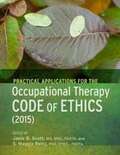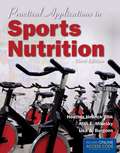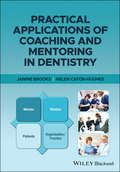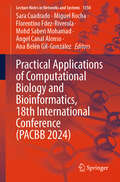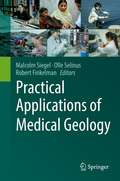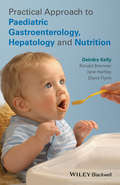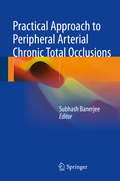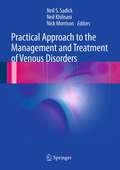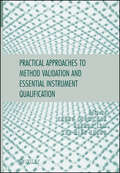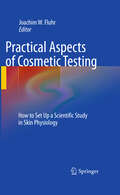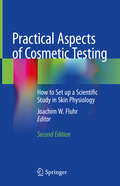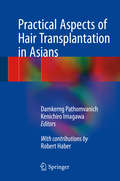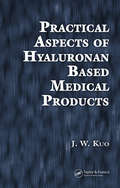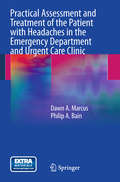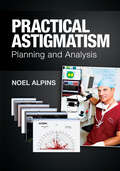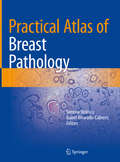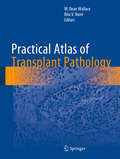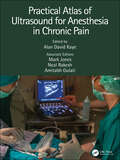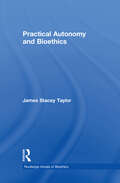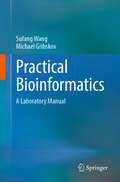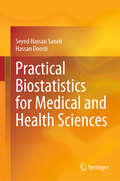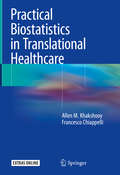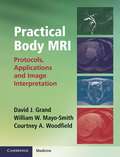- Table View
- List View
Practical Applications for the Occupational Therapy Code of Ethics (2015)
by S. Maggie Reitz Janie B. ScottFoundations, Principles, Applications, Trends.
Practical Applications in Sports Nutrition
by Heather Hedrick Fink Lisa A. Burgoon Alan E. MikeskyFink (educational services, National Institute for Fitness and Sport) et al. explain the link between diet and athletic performance showing how essential nutrients, energy metabolism, and sports performance interact. Chapters explain macronutrients, micronutrients, and water, and their relationships to athletic performance; practical and applied aspects of sports nutrition, including behavior change through consultations and weight management; endurance, strength/power, and teams; and jobs in the field. This edition has new 2010 dietary guidelines, the MyPlate initiative, and new calcium and vitamin D recommendations; more meal planning and snack ideas; a new sports beverage comparison chart; and updated research on carbohydrate intake and performance. It also has an expanded section on weight gain. The companion website contains a BMI calculator, a chemistry review, an interactive glossary, links and journals, quizzes and other learning tools, and recipes.
Practical Applications of Coaching and Mentoring in Dentistry
by Janine Brooks Helen Caton-HughesProvides an understanding of the theory of coaching and mentoring with practical applications within the field of dentistry Practical Applications of Coaching and Mentoring in Dentistry offers a comprehensive overview of the theory of coaching and mentoring as it applies to the field of dentistry. The book includes practical case studies that demonstrate how dental professionals have implemented coaching and mentoring into their daily practice. Grouped into themes such as remediation, foundation training, outreach training, and specialist practice, it also explains the coaching and mentoring techniques chosen and applied. Core topics include: A thorough introduction to the mechanics of mentoring The characteristics of typical mentors, mentoring engagements and the different types of mentoring What mentoring can achieve An exploration of business coaching, including the difference between mentoring and coaching Discussions of the various types of models used within mentoring and coaching Promoting the importance of coaching and mentoring, Practical Applications of Coaching and Mentoring in Dentistry highlights the positive impact and benefits, and is a valuable resource for dental professionals, dental organisations, and local dental committees.
Practical Applications of Computational Biology and Bioinformatics, 18th International Conference (Lecture Notes in Networks and Systems #1350)
by Florentino Fdez-Riverola Mohd Saberi Mohamad Miguel Rocha Sara Cuadrado Ana Belén Gil-González Ángel Canal AlonsoThis book aims to promote the interaction among the scientific community to discuss applications of CS/AI with an interdisciplinary character, exploring the interactions between sub-areas of CS/AI, Bioinformatics, Chemoinformatics and Systems Biology. The success of Bioinformatics in recent years has been prompted by research in Molecular Biology and Molecular Medicine in several initiatives. This year’s technical program presents both high quality and diversity, with contributions in well-established and evolving areas of research. The PACBB’24 technical program has selected 22 full papers in the main track and, as in past editions, it will be special issues in ranked journals. This symposium is organized by the BISITE Research Group of the University of Salamanca (Spain). The author would like to thank all the contributing authors, the members of the Program Committee, National Associations (AEPIA, APPIA), and the sponsors (AIR Institute).
Practical Applications of Medical Geology
by Olle Selinus Robert Finkelman Malcolm SiegelThis edited volume provides a framework for integrating methods and information drawn from geological and medical sciences and provides case studies in medical geology to illustrate the usefulness of this framework for crafting environmental and public health policies related to natural materials. The relevance of medical geology research to policy decisions is a topic rarely discussed, and this volume attempts to be a unique source for researchers and policy makers in the field of medical geology in addressing this gap in practical medical geology applications. The book's four sections establish this framework in detail using risk assessment, case studies, data analyses and specific medical geology techniques. Following an introduction to medical geology in the context of risk assessment and risk management, the second section discusses specific methods used in medical geology in the categories of geoscience, biomedicine, and data sources. The third section discusses the medical geology of natural materials, energy use, and environmental and workplace impacts. This section includes specific case studies in medical geology, and describes how the methods and data from the previous section are used in a medical geology analysis. The fourth section includes a guide to the medical geology literature and provides some examples of medical geology programs in Asia and Africa.
Practical Approach to Mammalian Cell and Organ Culture
by Tapan Kumar Mukherjee Parth Malik Srirupa MukherjeeThis Major Reference Work offers a detailed overview of culturing primary, secondary cell lines, tissues, and organs.It first introduces various types of mammalian cell cultures, infrastructure requirements for a mammalian cell-culture laboratory. The subsequent chapters present the detailed protocols for the isolation of mammalian hematologic organs and cells. It also discusses various cell-based assays for monitoring cell viability, cell proliferation, cytotoxicity, cell senescence, and cell death assays.In addition, the book addresses the various problems encountered while culturing animal cells, their possible causes, and suggested solutions, presenting detailed protocols for isolation and primary culturing of various mammalian cells and hematoimmunologic organs in two dimensions.Lastly, it reviews the various applications of animal-cell culture, stem-cell culture, and tissue and organ culture. As such, this reference book is highly relevant for students and professionals new to cell-culture work as well as to those wishing to expand their skills from cell-line cultures to primary cultures and from conventional 2D cultures to 3D cultures.
Practical Approach to Pediatric Gastroenterology, Hepatology and Nutrition
by Ronald Bremner Deirdre Kelly Diana Flynn Jane HartleyPractical, handy and succinct, this full colour pocketbook provides clear-cut clinical guidance to the main symptoms that infants and children commonly present with in both primary and secondary care.Clearly divided into specific sections covering the GI tract, liver and nutrition, Professor Kelly and her team discuss how best to investigate and manage specific clinical problems such as vomiting, abdominal pain, acute diarrhoea, constipation and jaundice using a highly clinical problem-orientated approach. They cover the management of important clinical problems such as chronic liver disease, ascites, malnutrition, obesity, coeliac disease and inflammatory bowel disease, and provide advice on nutritional problems in premature infants and children including weaning and food aversion.Key points, potential pitfalls, and management algorithms allow for rapid-reference, and link with the latest evidence, guidelines and protocols from ESPGHAN and NASPGHAN providing coverage of the major professional society recommendations for clinical practice. Brought to you by the experts, Practical Approach to Gastroenterology, Hepatology and Nutrition is the perfect accompaniment for trainees in gastroenterology, hepatology and pediatrics, as well as nutritionists, GI nurses and GPs.
Practical Approach to Peripheral Arterial Chronic Total Occlusions
by Subhash BanerjeeA practical, highly illustrative and easy to read reference for interventional cardiologists, vascular surgeons, cardiac/endovascular catheterization laboratory personnel, interventional radiologists, technical staff, industry professionals, investigators, and researchers on peripheral arterial CTO interventions. Peripheral CTO lesions are present in nearly 50% of all peripheral arterial disease (PAD) endovascular interventions. There is tremendous growth in the performance and learning of peripheral arterial CTO procedures. There are several ongoing physician courses and many others that are being prepared; however, there is a significant lack of standardized selection, strategies, techniques and equipment necessary to achieve a high degree of reproducible success with low complication rates during the performance of these complex and technically challenging endovascular procedures. The book is not an academic "tour de force" description of the topic but rather a practical one with many illustrations and step-by-step explanations of the various procedure steps, what can go wrong, and troubleshooting. Heavy use of illustrations throughout limit the text to what is necessary to convey the message, and the book is supported by online case catalogues and board review questions. The book also includes never-before-published information on new technology.
Practical Approach to the Management and Treatment of Venous Disorders
by Neil S. Sadick Nick Morrison Neil KhilnaniThis text evolved as a response to numerous requests to present a simplified approach to the diagnosis and management of most of the common aspects of both cosmetic and medical venous disorders. The authors, representing experienced plebologists from several different primary disciplines, have attempted to present simplistic paradigm-oriented approaches on how to thoughtfully evaluate and manage common vein issues with contemporary solutions. Several areas of phlebology were not addressed in this text. The management of vascular malformations are beyond the scope of this text and were not covered in detail. Although indications for the appropriate use of IVC filters are discussed, the details about the specific devices, their placement and removal are also beyond the scope of this text. Deep venous obstruction from prior thrombosis, venous compression by arteries such as the compression of the left common iliac vein by the right common iliac artery and pelvic venous insufficiency can now be managed with minimally invasive image guided treatments; the technical aspects of such treatments are complex and not discussed in detail in this handbook. This book will increase the therapeutic skill of the practicing phlebologist and thus increase the quality of care for patients faced with problems related to venous disorders.
Practical Approaches to Method Validation and Essential Instrument Qualification
by Xue-Ming Zhang Herman Lam Chung Chow ChanPractical approaches to ensure that analytical methods and instruments meet GMP standards and requirements Complementing the authors' first book, Analytical Method Validation and Instrument Performance Verification, this new volume provides coverage of more advanced topics, focusing on additional and supplemental methods, instruments, and electronic systems that are used in pharmaceutical, biopharmaceutical, and clinical testing. Readers will gain new and valuable insights that enable them to avoid common pitfalls in order to seamlessly conduct analytical method validation as well as instrument operation qualification and performance verification. Part 1, Method Validation, begins with an overview of the book's risk-based approach to phase appropriate validation and instrument qualification; it then focuses on the strategies and requirements for early phase drug development, including validation of specific techniques and functions such as process analytical technology, cleaning validation, and validation of laboratory information management systems Part 2, Instrument Performance Verification, explores the underlying principles and techniques for verifying instrument performance--coverage includes analytical instruments that are increasingly important to the pharmaceutical industry, such as NIR spectrometers and particle size analyzers--and offers readers a variety of alternative approaches for the successful verification of instrument performance based on the needs of their labs At the end of each chapter, the authors examine important practical problems and share their solutions. All the methods covered in this book follow Good Analytical Practices (GAP) to ensure that reliable data are generated in compliance with current Good Manufacturing Practices (cGMP). Analysts, scientists, engineers, technologists, and technical managers should turn to this book to ensure that analytical methods and instruments are accurate and meet GMP standards and requirements.
Practical Aspects of Cosmetic Testing
by Joachim W. FluhrSkin physiology assessment is moving rapidly from a descriptive approach to a deeper understanding of biophysical and biochemical processes in the stratum corneum, e.g. on stratum corneum barrier function as well on stratum corneum hydration. The research with bioengineering methods offers now reliable and reproducible approaches for product testing in the pharmaceutical and cosmetic industry as well as in basic research. This cookbook is intended to give basic information regarding skin physiology, the assessment of skin functions in controlled studies using non-invasive biophysical instruments. It provides basic knowledge on how to plan, perform and evaluate scientific studies. The authors are recognized expert in the field and provide comprehensive chapters with specific emphasis on the practical aspects of non-invasive measurements.
Practical Aspects of Cosmetic Testing: How to Set up a Scientific Study in Skin Physiology
by Joachim W. FluhrSkin physiology assessment is moving from a descriptive approach to a deeper understanding of biophysical and biochemical processes in the stratum corneum, such as epidermal barrier function and stratum corneum hydration. New, non-invasive approaches offer reliable and reproducible methods for product testing in the pharmaceutical and cosmetic industry, as well as in basic research. While standard instruments focus on functional aspects, innovative devices offer a deeper understanding of underlying mechanisms.This book discusses the assessment of skin physiology and of skin functions in clinical studies using non-invasive biophysical instruments, offering readers a comprehensive guide to planning, performing and evaluating the results of scientific studies in skin measurement and the legal framework for these studies. Written by leading experts in the field, it focuses on practical aspects of non-invasive measurements. After introducing the legal aspects of the current framework for clinical cosmetic studies and basic research in cosmetology, it explores the technical practicalities of organizing a testing lab and the pre-requirements for planning a study. The third and main section addresses specific topics in cosmetic testing e.g. skin hydration, and also includes chapters on sensory aspects and in vivo skin structure vizualization. This new, updated edition of Practical Aspects of Cosmetic Testing is a valuable tool for researchers, students, and medical staff wanting to gain insights into how best to assess skin functions in controlled studies using non-invasive biophysical instruments.
Practical Aspects of Hair Transplantation in Asians
by Damkerng Pathomvanich Kenichiro ImagawaThis book comprehensively discusses the practical aspects of hair transplantation in Asians. The demand for hair transplantation has increased globally in recent years and Follicular Unit Extraction (FUE) is gaining popularity. As such the book examines the techniques used by different ethnic group in Asia, included shaving, non-shaving FUE and robotic hair restoration surgery. With the help of illustrations, it describes surgical techniques and provides numerous practical tips. Written by leading experts and offering an overview of the current state of the art of hair restoration surgery, it enables experienced surgeons in the field to achieve optimal outcomes and to improve patients' QOL. It is a must read for hair surgeons performing hair transplantation on members of the Asian population.
Practical Aspects of Hyaluronan Based Medical Products
by J.W. KuoThe ballooning body of research devoted to hyaluronan (HA) reflects its enormous potential for various medical applications. There have been many successes of varying degrees in the development of medical products based on HA, but also some setbacks. While there is obviously ample information available on the chemistry and various properties of thi
Practical Assessment and Treatment of the Patient with Headaches in the Emergency Department and Urgent Care Clinic
by Dawn A. Marcus Philip A. BainMigraine is an extremely common condition affecting 28 million Americans. Fully 1 in every 6 adult women suffers from this malady. Patients with migraine are frequently seen in the Emergency Room and Urgent Care Clinic for acute treatment of their headaches. Headache generally accounts for nearly 3 % of all ER visits, resulting in almost 3.5 million visits annually. There currently are no widely used guidelines for the treatment of patients with headache in the ER or UCC, and reducing the number of CT scans remains a key goal for administrators in many ER or urgent care settings. In one study, 35 drugs, alone or in combination, were used to treat migraine. The most common medication class used was narcotics, which were used in 25% of the visits. The next two most commonly used classes were antiemetics and NSAIDs. Only 5% of patients seen for headache received headache-specific medications during their visit. ER and Urgent Care physicians generally have little or no formal training in treating these patients. Consequently, they often feel less comfortable ruling out secondary causes of headaches and using appropriate headache treatment medications and procedures. Since many patients have received narcotics in previous visits, providers may view them as drug seekers. Patients seen in ERs and UCCs for acute treatment of their headaches often report high levels of dissatisfaction. They often end up in the ER or UCC because they don't have a formal treatment strategy for their severe headaches. Health plans and insurance agencies are often frustrated by the high cost of fragmented care for patients with headaches. Because of the environment that most ER and UCC providers operate in, many unnecessary scans and tests are done because of uncertainty of the diagnosis and unfamiliarity of the patient. Primary care physicians are also frustrated by patients with headaches presenting to them after being seen in the ER or UCC, wanting a refill of their narcotics that they were given. Many patients don't follow up with their PCPs and simply keep returning to the ER/UCC for their treatment. In short, all involved in the care for patients with headache are frustrated by the current system. The care for these patients is clearly not optimal. It doesn't have to be that way. There are a wide variety of effective treatment options available, but are underutilized in the acute setting. With these treatment options, patients no longer have to be treated only with parenteral narcotics, only to perpetuate the cycle of suboptimal care described above. This concise handbook covers all aspects of acute headache care, including care of the child and adolescent with acute headaches, treatment of pregnant and breastfeeding women with acute headaches and appropriate evaluation of secondary headaches. In addition, two other novel chapters are included: one on caring for older patients with acute headaches as well as a chapter describing how to ensure a seamless transition of the patient back to a headache interested provider. Representing an important milestone in the care of patients with headache, this is the first concise handbook available to exclusively address the issue of headache treatment in the acute care setting. Including protocols and strategies that can be used right away, Management of Headaches in Emergency Room and Urgent Care Settings: Diagnosis and Management provides information about lesser known, but effective strategies such as greater occipital nerve blocks that can be easily learned and incorporated in the acute care setting. It emphasizes the continuity of care that is so vital to keep headache patients from returning to the ER and UCC for acute treatment.
Practical Astigmatism: Planning and Analysis
by Noel AlpinsThe surgical correction of astigmatism is the last frontier to optimizing visual outcomes for patients. Practical Astigmatism: Planning and Analysis is a comprehensive guide to correcting astigmatism from pre-operative planning to post-operative analysis. This provides readers with unique insight to what actually happened surgically: did the astigmatism over or under correct? Was it on-axis or off-axis? With this book, ophthalmologists will be able to analyze previous procedures with the appropriate nomograms and more often achieve targeted outcomes. Dr. Noel Alpins has developed the Alpins Method of astigmatism to provide accurate planning and analysis of astigmatism procedures. His method focuses on analyzing refractive and corneal astigmatism parameters and using the results in future surgery to improve visual outcomes. The importance of the ocular residual astigmatism (ORA) is detailed when planning astigmatism surgery.Practical Astigmatism features vector planning for refractive laser surgery as well as planning and analysis applied to cataract and limbal relaxing incisions, , in addition to demonstrating graphical analysis of astigmatism using high quality vector and fan diagrams, as used in scientific journals. In addition, hemidivisional analysis of the irregular cornea, corneal coupling in incisional and excimer laser surgery for mixed astigmatism and toric IOL planning with total corneal power using corneal topographic astigmatism (CorT total) are addressed as well.Some Questions Answered Inside: What is the difference between regular and irregular astigmatism? How do I diagnose each, and how does this affect my surgical technique? Can I incorporate corneal astigmatism when performing excimer laser surgery? Why are my LRIs undercorrecting the astigmatism? Is it safe to perform excimer laser on keratoconous patients? Which corneal astigmatism measure do I choose and what do I do following a refractive surprise? Practical Astigmatism: Planning and Analysis will help ophthalmologists, optometrists, and technicians alike address each patient’s unique circumstances and act as your in-depth guide to correcting astigmatism.Testimonials… “For more than three decades I have been listening to, arguing with, and admiring the work of Dr. Noel Alpins in the field of astigmatism. Despite his remote location on the small island of Australia, his knowledge of astigmatism is at the peak of Mt. Everest. There are few others who have devoted their careers to understanding and managing astigmatism for which the world of ophthalmology is truly grateful.” - Robert H. Osher, MD “Noel is an original thinker who took on and conquered the complexities of astigmatism analysis, publishing the seminal papers on the way. His work has formed the cornerstone from which our current understanding and management of astigmatism has been built. He is someone from whom we have all learnt a great deal and this book is a testament to this.” - Dan Z Reinstein, MD MA(Cantab) FRCSC DABO FRCOphth FEBO
Practical Atlas of Breast Pathology
by Simona Stolnicu Isabel Alvarado-CabreroThis book presents the basic concepts for understanding and practicing breast pathology in routine practice. It explains how to tackle the diagnosis, emphasizing diagnostic clues for each entity as well as pitfalls and mimickers. Each chapter has concise, relevant text illustrated by numerous high-quality pictures highlighting the pearls and challenges in the diagnosis of breast lesions. Experts from around the world describe common and rarer conditions affecting the breast. Histology, immunohistochemistry, cytology, radiology and key morphologic criteria are covered. The book includes a chapter dedicated to breast normal histology, which is very important for understanding breast pathology, and a separate chapter for breast radiology, which is essential in understanding and diagnosing the breast lesions especially in a multidisciplinary team. Also, there is a chapter with the latest TNM staging system as well as the recently revised World Health Organization classification of breast tumors. Since in many breast units the cytology is still used to diagnose breast lesions there is a chapter dedicated to this technique. This book is aimed at trainees and practicing pathologists in surgical pathology, particularly those with an interest in breast pathology and those tackling the daily sign-out.
Practical Atlas of Transplant Pathology
by W. Dean Wallace Bita V. NainiThis atlas describes and illustrates the pathology of solid organ transplants and includes chapters covering transplant pathology of the kidney, lung, heart, liver, pancreas, small bowel and limbs. Each of these chapters briefly reviews the latest rejection classifications for each organ system with explanatory notes highlighting diagnostic criteria, and tables listing entities in the differential diagnosis. Included with each chapter are images demonstrating the pathology of the most common and important diseases, especially patterns of organ rejection and related entities or mimickers. Examples of classic disease processes are provided, as well as atypical presentations that may highlight and prevent diagnostic pitfalls. A comprehensive explanation of the immunogenetics of transplant rejection is included, enabling the general pathologist to become familiar with the most important aspects of serologic testing in this patient population. A review of post-transplant lymphoproliferative diseases is also provided. Practical Atlas of Transplant Pathology is aimed at both general and expert pathologists who encounter transplant pathology specimens in their practice.
Practical Atlas of Ultrasound for Anesthesia in Chronic Pain
by Alan David Kaye Mark Jones Amitabh Gulati Neal RakeshThe use of ultrasound to help clinicians specializing in the treatment of chronic pain has expanded greatly over recent years; this illustrated text from a team of experts gives both the experienced practitioner and the trainee a state-of-the-art course in safe and effective techniques. Summarizing the essential information concisely, each chapter presents a practical and visual summary of the nerve blocks indicated as an indispensable atlas resource for a pain management clinic.
Practical Autonomy and Bioethics (Routledge Annals of Bioethics)
by James Stacey TaylorThis is the first volume in which an account of personal autonomy is developed that both captures the contours of this concept as it is used in social philosophy and bioethics, and is theoretically grounded in, and a part of, contemporary autonomy theory. James Stacey Taylor’s account is unique as it is explicitly a political one, recognizing that the attribution of autonomy to agents is dependent in part on their relationships with others and not merely upon their own mental states. The volume is distinctive in its examples, which touch on the ethics of using inducements to encourage persons to participate in medical research, the ethical issues associated with the use of antibiotics, and the ethical basis for both patient confidentiality and informed consent.
Practical Bioinformatics: A Laboratory Manual
by Michael Gribskov Sufang WangThis book is a lab manual which can be integrated with bioinformatics course. The field of bioinformatics is advancing at a remarkable rate. With the development of new analytical techniques that make use of the latest advances in machine learning and data science, today&’s biologists are gaining fantastic new insights into the natural world&’s most complex systems. This book includes a lab-based manual that can assist students handling large biological data. It aims to help students and researchers understand (1) the importance of horizontal transfer in the spread of antibiotic resistance, and in biology more broadly; (2) how protein and nucleic acid sequences are used to determine phylogenetic trees and the genetic relationship between organisms; (3) how sequence comparisons can be used to infer protein function; and (4) how to analyze high-throughput sequencing data to do gene expression analysis. This book is valuable for researchers, teachers and students, as well as any readers who are interested in bioinformatics.
Practical Biomedical Signal Analysis Using MATLAB® (Series in Medical Physics and Biomedical Engineering)
by Katarzyna J. Blinowska Jarosław ŻygierewiczCovering the latest cutting-edge techniques in biomedical signal processing while presenting a coherent treatment of various signal processing methods and applications, this second edition of Practical Biomedical Signal Analysis Using MATLAB® also offers practical guidance on which procedures are appropriate for a given task and different types of data. It begins by describing signal analysis techniques—including the newest and most advanced methods in the field—in an easy and accessible way, illustrating them with Live Script demos. MATLAB® routines are listed when available, and freely available software is discussed where appropriate. The book concludes by exploring the applications of the methods to a broad range of biomedical signals while highlighting common problems encountered in practice. These chapters have been updated throughout and include new sections on multiple channel analysis and connectivity measures, phase-amplitude analysis, functional near-infrared spectroscopy, fMRI (BOLD) signals, wearable devices, multimodal signal analysis, and brain-computer interfaces. By providing a unified overview of the field, this book explains how to integrate signal processing techniques in biomedical applications properly and explores how to avoid misinterpretations and pitfalls. It helps readers to choose the appropriate method as well as design their own methods. It will be an excellent guide for graduate students studying biomedical engineering and practicing researchers in the field of biomedical signal analysis. Features: Fully updated throughout with new achievements, technologies, and methods and is supported with over 40 original MATLAB Live Scripts illustrating the discussed techniques, suitable for self-learning or as a supplement to college courses Provides a practical comparison of the advantages and disadvantages of different approaches in the context of various applications Applies the methods to a variety of signals, including electric, magnetic, acoustic, and optical Katarzyna J. Blinowska is a Professor emeritus at the University of Warsaw, Poland, where she was director of Graduate Studies in Biomedical Physics and head of the Department of Biomedical Physics. Currently, she is employed at the Institute of Biocybernetics and Biomedical Engineering of the Polish Academy of Sciences. She has been at the forefront in developing new advanced time-series methods for research and clinical applications. Jarosław Żygierewicz is a Professor at the University of Warsaw, Poland. His research focuses on developing methods for analyzing EEG and MEG signals, brain-computer interfaces, and applications of machine learning in signal processing and classification.
Practical Biostatistics for Medical and Health Sciences
by Seyed Hassan Saneii Hassan DoostiThis book addresses the challenge of presenting biostatistics to medical and health science audiences coherently. Tailored for students and researchers, its 13 chapters progress logically from foundational concepts like measurement scales and statistical calculations to advanced topics such as probability, correlation, regression and health and disease measures. Practical examples enhance relevance, and its gradual approach ensures easy comprehension even for non-statisticians. The book's practical emphasis shines as it culminates in teaching the use of SPSS software for result interpretation, bridging theory and practice effectively. It empowers medical professionals to confidently understand and apply statistical concepts in their work, serving as an indispensable resource in navigating the intricacies of biostatistics in medical and health sciences.
Practical Biostatistics in Translational Healthcare
by Francesco Chiappelli Allen M. KhakshooyThere is an ever-increasing emphasis on evidence-based medicine that is distinguished by systematic crafting of the patient-centered research question, detailed literature searches, and careful appraisal of the resulting evidence. The consensus that ultimately emerges must then be applied in specific clinical settings, and it is to this process that translational effectiveness analysis refers. This portable and easy-to-use handbook is intended as a practical teaching guide on translational effectiveness for students and clinicians. Specifically, it will serve as a primer on patient-centered outcomes research methodology in the health sciences and explain how to acquire and understand the fundamental data that determine which reports are valued as the “best available” evidence. It presents an accessible and readily intelligible set of principles which doctors, dentists, nurses, and insurance carriers will be able to use in the process of health care-related decision-making.
Practical Body MRI
by David J. Grand Courtney A. Woodfield William W. Mayo-SmithPractical Body MRI: Protocols, Applications and Image Interpretation demystifies MRI examinations of the abdomen and pelvis, giving the essential knowledge required by radiologists in order to develop and select appropriate protocols, assess scan quality and interpret imaging studies. Each chapter describes why each sequence is performed, what to look for, and how the important findings from each sequence lead to a unique diagnosis. Numerous protocols are included, from the more common, such as liver and renal MRI, to more tailored examinations such as rectal and placental MRI. All protocols are richly illustrated with images of body MR pathology. A separate chapter discusses MRA/MRV and an introductory chapter gives a brief, practical introduction to MRI physics and receiver coils. The authors' expertise and practical, concise explanations of both protocols and image interpretation makes this an essential resource for residents, fellows and experienced radiologists using body MRI for the first time.
